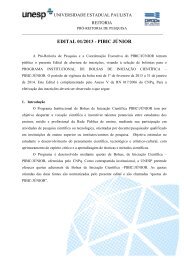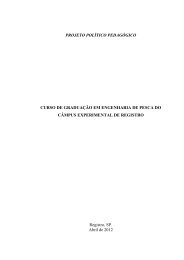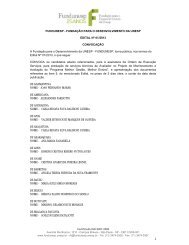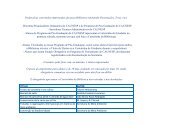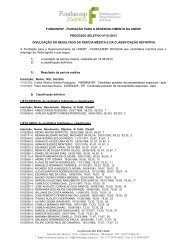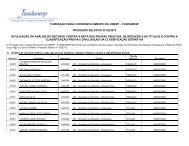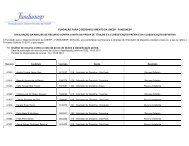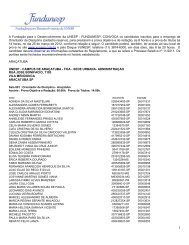SURFACE ROUGHNESS EFFECT ON THE B's ... - LabCACC
SURFACE ROUGHNESS EFFECT ON THE B's ... - LabCACC
SURFACE ROUGHNESS EFFECT ON THE B's ... - LabCACC
You also want an ePaper? Increase the reach of your titles
YUMPU automatically turns print PDFs into web optimized ePapers that Google loves.
-<strong>LabCACC</strong> tips on the Rietveld Method. Publication #1. http://labcacc.iq.unesp.br ----------------------------------------------------------------------------------------------------------------------------------------------------------------------------and lower the intensities at high angles due to the scattering factor effect. It means thatsmaller values of Bj will increase the relative intensities at higher angles.Let’s suppose a refinement being performed with X-ray diffraction data of a samplewith significant surface roughness. If the SR effect is not being considered in the refinement,then the isotropic atom displacement will converge to small (even negative) values in order toincrease the relative intensities at higher angles. The scale factor will, then, become lower. Inthat case, it is preferable to keep the negative values for Bj, even knowing that it does nothave physical meaning, than fixing it to some positive values. The reason is that atompositions can converge to more reasonable values, given meaningful interatomic distancesand angles. The Figure 1 can exemplify this effect. In this Figure are graphic representationsfor various values of surface roughness and atoms displacement. The surface roughnesseffect is simulated according the Suortti model (eq. 2) (Suortti et al., 1972).where p and q are refinable parameters.SR = 1.0 - p·e (1-q) - p·e (-q/sinθ) (2)To exemplify these effects several simulations were done for SnO 2 andLa 0.77 Sr 0.23 MnO 3 . These materials were chosen due to the moderate to high absorptioncoefficient [µ(SnO 2 )= 197.23 cm 2 .g -1 , µ(La 0.75 Sr0 .25 MnO 3 ) = 238.58 cm -2 .g -1 ] and also becausethey are common materials in our Laboratories.150Bj = -1 (isotropic atom displacement)125Relative Intensity (%)100755025p = 1.0, q = 0.0 (no SR effect)p = 1.0, q = 0.01p = 1.0, q = 0.1Bj = 1.0 (isotropic atom displacement)f j(scattering factor)05 25 45 65 85 105 125 1452θ/degreesFigure 1. Surface roughness and atom displacement effects on the relative intensities at 2θpositions. The Suortti model was used for simulations of SR effect.
-<strong>LabCACC</strong> tips on the Rietveld Method. Publication #1. http://labcacc.iq.unesp.br ----------------------------------------------------------------------------------------------------------------------------------------------------------------------------2. ExperimentalThis work was done in two parts. Part one was for simulations and part two was forreal cases where negative isotropic atoms displacements appeared at the end of therefinements without surface roughness corrections. All calculations were performed with theRietveld refinement program DBWS-9807 (1994, 1998). Data were generated in the range20-120 degrees (2θ), with step scan = 0.02° (2θ). Other conditions for simulations are intable I. The profile function was the pseudo-Voigt (eq. 3).pV = ηL + (1-η)G (3)where η = NA + NB*2θ, NA and NB are refinable parameters.The Suortti model (eq. 2) was used to generate and correct the surface roughnesseffect.Table I. Results of the SnO 2 refinements with simulated data.In all cases p = 1.00. “Or. q” is the original value used to generate the pattern. Initial values crystalstructure and FWHM are B(Sn 4+ ) = 0.5, B(O 2- ) = 0.8, and x(oxygen) = 0.30715, Scale factor =.111exp(-2). U = 0.08, V = -0.001, W = 0.05, NA = 0.78 and NB = 0.002. ScaleF is the scalefactor.Cond Or.q q B(Sn) B(O) x(Oxyg.) ScaleF Rwp R Ba .1 .0 .50 .80 .3019(4) .973e-3 8.37 9.15b .1 .0 -.013(5) .11(4) fixed .890e-3 4.85 4.75c .1 .0 -.005(5) .11(4) .3043(2) .892e-3 4.78 4.70d .1 .1000(5) .501(2) .805(8) .30712(4) .111e-2 0.0 0.0a .2 .0 .5 .8 .294(1) .877e-3 14.14 15.84b .2 .0 -.362(8) -.30(6) fixed .759e-3 8.13 8.10c .2 .0 -.349(8) -.29(6) .3029(4) .761e-3 8.03 8.17d .2 .1998(8) .501(2) .809(8) .30715(4) .111e-2 0.0 0.092.1. SimulationsTwo data set for the SnO 2 crystal structure were generated. One for p = 1.0 and q =0.1 and other for p = 1.0 and q = 0.2. The refinements were then done for the followingconditions:(a) p = 1 and q = 0.0 fixed (without surface roughness correction): Refining scale factor,x(Oxygen).(b) p = 1 and q = 0.0 fixed (without surface roughness correction): Refining scale factor,B(Sn) and B(Oxygen).
-<strong>LabCACC</strong> tips on the Rietveld Method. Publication #1. http://labcacc.iq.unesp.br ----------------------------------------------------------------------------------------------------------------------------------------------------------------------------(c) p = 1 and q = 0.0 fixed (without surface roughness correction): Refining scale factor,B(Sn), B(Oxygen), x(Oxygen).(d) p = 1.0 fixed: Refining scale factor, B(Sn), B(Oxygen), x(Oxygen), and q. The results arein table I.Figure 2 is the Rietveld plot for the data generated with q = 0.2 and refined with qfixed in zero (case C). Note that the calculated-after-refinement pattern has peak at lowangles with higher intensity than the generated (observed) pattern.Another simulation was performed for La 0.77 Sr 0.23 MnO 3 . In this case, the data weregenerated with the crystal structure resulted in a real refinement with synchrotron data, a SRparameter q = 0.2, and the stoichiometric parameter φ = 0.23. The refinement using thisgenerated data was performed first for 19 parameters (3 for crystal structure, 6 for profile andshape, scale factor, 3 for background parameters and one for preferred orientation). Afterconvergence, the SR parameter q was also refined.Figure 2. Rietveld plot for SnO 2 using the data generated with surface roughness parameters p= 1.0 and q = 0.2.The Figure 3 is the Rietveld plot at the end of the refinement with the 19 parameters(no SR correction). Numerical results for this simulated refinement are in table II.
-<strong>LabCACC</strong> tips on the Rietveld Method. Publication #1. http://labcacc.iq.unesp.br ----------------------------------------------------------------------------------------------------------------------------------------------------------------------------Table II. Results of the La oxide refinements with simulated data.Parameters used to generate the data are: p = 1.00, q = 0.20, Scale factor = .197exp(-4). U =0.0814, V = 0.02448, W = 0.00209, NA = 0.3188 and NB = 0.0043. SG = R3 c , a = 5.5085 Å, c =13.3798 Å. Atomic positions: La/Sr (0,0,1/4), Mn (0,0,0), O (x,0,1/4). φ = .7677. Preferredorientation was also supposed for (1 0 4) with G = .79476 (around 21% of material in preferredorientation, March-Dollase function). The monochromator polarization factor was put to zero,supposing an ideal synchrotron radiation. ScaleF is the scale factorq B(La/Sr) B(Mn) B(O) x(Oxyg.) ScaleF Rwp R B φ.2 .57881 .34596 .85635 .54068 .197e-4 = Original values0 -.43(1) -.22(2) -.03(5) .5420(5) .173e-4 6.48 5.88 624(6).201(2) .56(1) .34(1) .84(2) .5408(2) .196e-4 1.00 0.0 .766(2)Figure 3. Rietveld plot for La 0.77 Sr 0.23 MnO 3 using the data generated with surface roughnessparameters p = 1.0 and q = 0.2.2.1.1. DiscussionsSnO 2 caseFor all refinements with SR parameter fixed (q = 0.0) the atom displacementparameters converged to lower values than the one used to generate the data. For higher SReffect both Sn +4 and O 2- displacement reached negative values. It is interesting to note thatwhen keeping B(Sn) and B(O) fixed in the original values the Bragg factor R B and weightedprofile factor Rwp reached very high values. Also the oxygen x-position converged to values
-<strong>LabCACC</strong> tips on the Rietveld Method. Publication #1. http://labcacc.iq.unesp.br ----------------------------------------------------------------------------------------------------------------------------------------------------------------------------far from the original one. When the atoms displacement parameters were refined, theyconverged to lower (even negative) values and the R B and Rwp reached smaller values. Alsothe x-oxygen position converged to a value closer to the original. So, although the negativeatom displacements are non-sense, it is a try of the least squares process to correct the SReffect. For atomic position the result with negative B’s was better than the result with no SRcorrection and B’s fixed at real values. After including the q SR parameter to be refined allvalues converged to the expected one. (Expected values here are considered the ones usedfor data generation.)The decrease in Rwp and R B in the cases b and c, when compared to the casea, is a clear indication that the B values converging to lower values than the expected are dueto the tentative of the Rietveld program to correct the lost of intensity at smaller anglescaused by the supposed (generated) SR effect. Although the results in cases b and c arebetter than in case a , it can not be considered, at least in these cases with very high SReffects, as an alternative for the surface roughness correction. Besides, the scale factorreaching lower values than the expected is another source of error in quantitative phaseanalysis, i.e., phases with peaks at lower 2θ angles will have their scale factor converging tolower values, resulting in smaller weight fraction in QPA analysis by the method of Howardand Hill (1987).La 0.77 Sr 0.23 MnO 3 caseFor this manganite case the results were quite similar to the SnO 2 case. When theSR parameter was not refined, the scale factor and atoms displacement converged to smallervalues than expected. Also the final value of the only one positional parameter refinable wasfar from the expected one. The La and Sr occupation factors, restrained to have their sumequal to the unit, converged to wrong values. The Rwp and R B also reached very high values.After refining for the SR effect all parameters converged to the expected ones.2.2. Real CasesLa 1-φ Sr φ MnO 3 :The perovskite type structure lanthanum-strontium manganites (La 1-φ M φ MnO 3 ) hasbeen pointed as a material of great technological interest due to its giant negative
-<strong>LabCACC</strong> tips on the Rietveld Method. Publication #1. http://labcacc.iq.unesp.br ----------------------------------------------------------------------------------------------------------------------------------------------------------------------------magnetoresistence around the Curie temperature (Alonso et. al, 1997, Asamitu et. al., 1996,1996).Sample of La 0.7 Sr 0.3 MnO 3 was obtained from an alternative methodMarques et al.,1999) based on oxygen raising solid state oxidation reaction without oxygen atmosphere flux,where the chemical strategy was an in-situ oxidation by strontium peroxide. The refinementwithout the surface roughness correction gave values of B with no physical meaning and afterthe SR correction these values became reasonable. The synchrotron data were collect at theXRD line in the Laboratorio Nacional de Luz Síncrotron in Brazil, in the early days ofoperation (http://www.lnls.br).The crystal structure of lanthanum-strontium-manganese oxides has been describedas monoclinic P2/c [PDF file # 40-1100 (PDF, 1996), Hashimoto et al., 1987), rhombohedralR3 c (Alonso et al., 1997, Asamitsu et al., 1995, 1996), and tetragonal I4/mmm (Bouloux etal., 1981). In this work we tried all crystal structures above and the rhombohedral producedthe best result. The starting values was taken from the nonstoichiometricR3 c crystalstructure of La 0.93 MnO 3 given by Habekost et al. (1994), with the Sr sharing the samecrystallographic site of La and initial occupation factor equal to 0.70.The data collection conditions and results are in table III. For the synchrotron case,the refinements were conducted first with no SR correction and the atoms displacementconverged to very low values. Then, the refinements were conducted with alternating the SRparameters p and q versus all the atoms displacements. Final cycles were conducted for 19parameters; with the SR parameters fixed in the value converged in the previous cycle. Theatoms displacement converged to reasonable numbers and the φ parameter reached a value(=0.33) closer to the expected 0.30. The final Rwp factor is very high, but it is important tonote that the expected index is also high and gave a goodness of fit of only 1.31. Figure 4 isthe Rietveld plot after the final refinement. The weighted R factor is slightly higher for thecase with SR correction, and the R B , although slightly lower, is still too high. The bad qualityof the data is responsible for the bad results.
-<strong>LabCACC</strong> tips on the Rietveld Method. Publication #1. http://labcacc.iq.unesp.br ----------------------------------------------------------------------------------------------------------------------------------------------------------------------------Figure 4. Rietveld plot for the La 0.77 Sr 0.23 MnO 3 with synchrotron data.The refinements were also conducted with XRD data collected in a commercialdiffractometer with sealed tube. Experimental data collection conditions are also in table III.The refinements were performed like in the synchrotron case, with SR effect correction. Theresults are also in Table III and in Figure 5 is the Rietveld plot at the end of the refinement.The R factors are smaller for this data set. The Bragg R factor of 3.37 confirms the goodagreement of the crystal structure model and the observed data.Figure 5. Rietveld plot for the La 0.77 Sr 0.23 MnO 3 with sealed tube data.
-<strong>LabCACC</strong> tips on the Rietveld Method. Publication #1. http://labcacc.iq.unesp.br ----------------------------------------------------------------------------------------------------------------------------------------------------------------------------Table III. Data collection conditions and refinements results for La x Sr 1-x MnO 3 . W is theWyckoff number. Space group: R3 cSynchrotron data: λ = 1.1944 Å, Soller slit, count time per step = 5 s, 16.00 ≤ 2θ ≤ 72.99°,∆2θ = 0.02, Counter dead time = 400ηs.Results WITHOUT refinement of surface roughnessW X Y Z Biso occ. factor6 LA+3 .00000 .00000 .25000 -.22(8) .66(3)6 SR+2 .00000 .00000 .25000 -.22(8) .3443)6 MN+3 .00000 .00000 .00000 .0(1)18 O-1 .541(3) .00000 .25000 .1(3)a = 5.5085(3), c = 13.3798(8), V = 351.60(3)Å 3 , ρ x = 6.367gr.cm -3Scale factor = .159(4)x10 -4R p = 22.31 R wp = 31.18 S = 1.31 R B = 9.09Results WITH refinement of surface roughnessW X Y Z Biso occ. factor6 LA+3 .00000 .00000 .25000 .26(8) .68(3)6 SR+2 .00000 .00000 .25000 .26(8) .32(3)6 MN+3 .00000 .00000 .00000 .3(1)18 O-1 .541(3) .00000 .25000 .7(3)a = 5.5106(3), b = 13.3840(8) V = 351.98(3)Å 3 , ρ x = 6.382gr.cm -3Scale factor = .189(5)x10 -4p = .310 , q = .414 (refined values)R p = 22.17 R wp = 31.04 S = 1.30 R B = 8.71Sealed Tube data: secondary graphite monochromatized Cu-kα , 20 ≤ 2θ ≤ 100°, ∆2θ =0.02°, t = 5s, Ikα 2 /Ikα 1 = 0.5, ds = 2 mm, rs = 0.6 mm. Analytical correction for surfaceroughness (Suortti model.)W X Y Z Biso occ. factor6 LA+3 .00000 .00000 .25000 .22(2) .654(9)6 SR+2 .00000 .00000 .25000 .22(2) .346(9)6 MN+3 .00000 .00000 .00000 .04(4)18 O-1 .5405(8) .00000 .25000 .7(1)a = 5.5032(1) c = 13.3675(4) V = 350.60(2)Å 3 , ρ x = 6.382gr.cm -3Scale factor = .740(6)x10 -4p = .938 , q = .024 (refined values)R p = 11.44 R wp = 17.52 S = 1.38 R B = 3.37The results for synchrotron and Sealed tube data are quite similar. The difference inthe unit cell is due to the fact that the synchrotron wavelength was not pre-calibrated with astandard sample. Then the inaccuracy in the wavelength was absorbed by the unit cellparameters. No problems were detected in the background fitting for either case. Some small
-<strong>LabCACC</strong> tips on the Rietveld Method. Publication #1. http://labcacc.iq.unesp.br ----------------------------------------------------------------------------------------------------------------------------------------------------------------------------asymmetry bad fitting occurred in both cases, and it can be related to bad displacementatoms.2.3. The crystal structure of La 0.67 Sr 0.33 MnO 3 .The crystal structure described here is based in the results of the refinements withconventional X-ray diffraction data.The lanthanum atom is coordinated by 9 oxygen atoms, which form a tricappedtrigonal prism. The Mn atom is coordinated by six oxygen forming a irregular octahedra(trigonal anti-prism). Figure 6 shows the coordination polyhedras for Mn, La/Sr and aperspective view of the crystal structure of the lanthanum strontium manganite.(a)(b)(c)Figure 6. a) Coordination polyhedras for Mn (CN = 6), b) for La (CN = 9) with someinteratomic distances, c) perspective view of the lanthanum strontium manganite and the unitcell.The interatomic distances are in table IV together with the interatomic distances forsome rhombohedral lanthanum manganites found in the literature (Van Roosmalen et al.,1994, habekost et al., 1994,Ferris et al., 1995). The mean interatomic distance from La to alloxygen of the prism is 2.68 Å in this work while it is around 2.62 Å for the other cases.
-<strong>LabCACC</strong> tips on the Rietveld Method. Publication #1. http://labcacc.iq.unesp.br ----------------------------------------------------------------------------------------------------------------------------------------------------------------------------According Shannon (1976) for coordination number (CN) equal to 9, the Sr 2+ and La 3+ ionicradius are 1.31Å and 1.216 respectively. That can explain the increase in the meaninteratomic distance La-O in the tricapped trigonal prism. The decrease in the Mn-Ointeratomic distance can be explained if the Mn valence changes from 3+ to 4+. The ionicradii for them are 0.645 Å and 0.530 Å respectively. The ratio of Mn 4+ /Mn 3+ in the structureshould be equal to the ratio of Sr 2+ /La 3+ for maintaining the charge equilibrium. It means thatthe unit formula is then (La 3+ 0.67Sr 2+ 0.33)(Mn 3+ 0.67Mn 4+ 0.33)O 3 .The bond valence for La/Sr and Mn sites were then computed (Brown and Altermatt,1985) supposing the chemical unit formula above. for comparison it was also calculated forthe cases of the literature.The atomic valence Vi of an atom i is defined as the sum of the bond valences v ij ofall the bonds from atom i to atoms j,Σ i v ij = V i .The most commonly adopted empirical expression for the bond valence v ij as afunction of the interatomic distance d ijv ij = exp[(r 0 – d ij )/B]The parameter B is commonly taken to be a "universal" constant equal to 0.37 Å(Brown and Altermatt, 1985). Values of the reference distance r o are tabulated for variouspairs of atoms in the papers of Brown and Altermatt (1985).3.54Table IV. Interatomic distances and bond valence for the manganite, calculated with theRietveld refinements with conventional X-ray diffraction data.This Work H1994 VR1994 F1995Unit cell a(Å) 5.5032(1) 5.529 5.528 5.532c(Å) 13.3775(4) 13.363 13.327 13.337Volume(Å 3 ) 350.60(2) 353.78 352.69 353.476 bonds La/Sr-O 2.747(4) 2.774 2.774 2.7763 bonds La/Sr-O 2.529(4) 2.303 2.303 2.3056 bonds Mn - O 1.953(4) 1.998 1.998 1.999Bond ValenceLa/Sr site experimental * 2.31 3.06 3.12 3.09mominal * 2.67 2.79 2.85 2.84Mn site experimental *3.15 3.00 2.97mominal * 3.33 3.33 3.15 3.17This work: La 0.654 Sr 0.346 Mn O 3 .H1994: Habekost et al(1994). La 0.93 Mn O 3 .VR1994: Van Roosmalen et al (1994). La 0.95 Mn 0.95 O 3 .F1995: Ferris et al. (1995). La 0.945 Mn 0.945 O 3 .* : Nominal weighted valence.
-<strong>LabCACC</strong> tips on the Rietveld Method. Publication #1. http://labcacc.iq.unesp.br ----------------------------------------------------------------------------------------------------------------------------------------------------------------------------The nominal valences were calculated considering the valence and fraction of eachion for each cation site. The results are also in table IV.In this work it was observed that the bond valence for the La/Sr site is smaller thanits nominal value, indicating that the bond strength between the oxygen and the La/Sr is weakand the cations are rattling at the La site. For the Mn the bond valence is bigger than thenominal value indicating that the bond strength between the oxygen and Mn cations is strong.For all cases in the literature the La and Mn bond valence are respectively bigger and smallthan the corresponding nominal value. That suggests that the initial inclusion of Sr on the Lasite in the manganite is only possible at high temperatures. Once the inclusion process starts,the bond valence tends to decrease and new ions could go to the La site at temperaturesprogressively lowers.3. ConclusionsA correction for surface roughness is very important in Rietveld refinements andmust be done mainly for highly absorbing and rough materials. The Suortti modelincorporated in the Rietveld refinement program DBWS-9807a can be used for suchpurposes. It will permit to reaching non-negative atoms displacements and meaningfulstoichiometry.Negative atom displacement (B) is not a disease but a symptom of a problem that isnot being considered in the refinement. Rietveld users must take care about it and check forsurface roughness besides background, atom position, etc.ACKNOWLEDGEMENTS. The authors acknowledge FAPESP and CNPq for financialsupport. We also acknowledge the LNLS-Brazil for the data collection.4. ReferencesAlonso, J. A., Martínez-Lope, M. J., Casais, M. T., MacManus-Driscoll, J. L., Silva, P.S. I. P. N., Cohen, L. F., and Fernández-Días, M. T. (1997). “Non-stoichiometry structuredeffects and properties of LaMnO 3-δ with high δ values (0.11≤δ≤0.25)”. J. Matter. Chem. 7,2139-2144.Asamitsu, A., Moritomo, Y., Kumai, R., Tomioka, Y., and Tokura, Y. (1996).“Magnetostructural phase transitions in La 1-x Sr x O 3 with controlled carrier density.” Phys. Rev.B 54, 1716-1723.Asamitsu, A., Moritomo, Y., Tomioka, Y., Arima, T., and Tokura, Y. (1995). “Astructural phase transition induced by na external magnetic fiel.” Nature 373, 407-409.Bouloux, J. C., Soubeyroux, J. L., Daoudi, A., and Flem, G. (1981). “Proprietesmagnetiques de la phase Sr 1.5 La 0.5 MnO 4 .” Materials Research Bulletin, 16, 855-860.
-<strong>LabCACC</strong> tips on the Rietveld Method. Publication #1. http://labcacc.iq.unesp.br ----------------------------------------------------------------------------------------------------------------------------------------------------------------------------Habekost, A., Norby, P., Jorgensen, J. E. Lebech, B. (1994). “neutron and X-raypowder diffraction studies of lanthanum manganite, a nonstoichiometric perovskite.” ActaChem. Scandinavica, 48, 377-381.Hashimoto, T. et al., (1987). “Crystal growth and characterization of La 1-x M x MnO 3 (M= Ce, Sr).” J. Cryst. Growth, 84 207-211.Pitschke W, Hermann H, and Mattern N, (1993a). “The influence of surfaceroughness on diffracted X-ray intensities in Bragg-brentano geometry and its effect on thestructure determination by means of Rietveld analysis.” Powder Diffraction 8, 74-83.Pitschke W, Mattern N, and Hermann H, (1993b). “Incorporation of microabsorptioncorrections into Rietveld analysis.” Powder Diffraction 8, 223-228.Powder Diffraction File (1996). International Centre for Diffraction Data, 12 CampusBlvd., Newtown Square, PA 19071-3273.Marques, R.F.C, zorel-Jr, H. E., Jafelicci, M., Crespi, M. S., Paiva-Santos, C. O.Godoi, R. H. M. and Varanda, L. C. (1999). “Thermal and Crystallographic Studies of MixedLa 2 O 3 /SrO prepared Via Reaction in Solid State.” Journal of Thermal analysis andCalorimetry, Vol. 56, 143-149.Sparks CJ, Kumar R, Specht ED, Zschack P and Ice GE, (1992) “Effect of Powdergranularity on Fluorescent Intensity and on Thermal Parameters in X-ray Diffraction Rietveldanalysis.” Adv. in X-RayAnalysis 35, 57-62.Suortti P, (1972) “Effects of porosity and surface roughness on the x-ray intensityreflected from a powder specimen.” J. Appl. Cryst. 5, 325-331.Young R. A., Sakthivel A., Moss T. S. and Paiva-Santos C. O. (1995) "DBWS-9411,an Upgrade of the DBWS*.* Programs for Rietveld Refinement with PC and MainframeComputers", J. Appl. Cryst. 28, 366-367.R. A. Young, Allen C. Larson and C.O. Paiva-Santos. (1999). “USER’S GuideUSER'S GUIDE to PROGRAM DBWS-9807a for RIETVELD ANALYSIS OF X-RAY ANDNEUTR<strong>ON</strong> POWDER DIFFRACTI<strong>ON</strong> PATTERNS with a `PC' and various other computers.(release 21.05.1999)”, 71p. School of Physics, Georgia Institute of Technology, Atlanta, GA30332.




